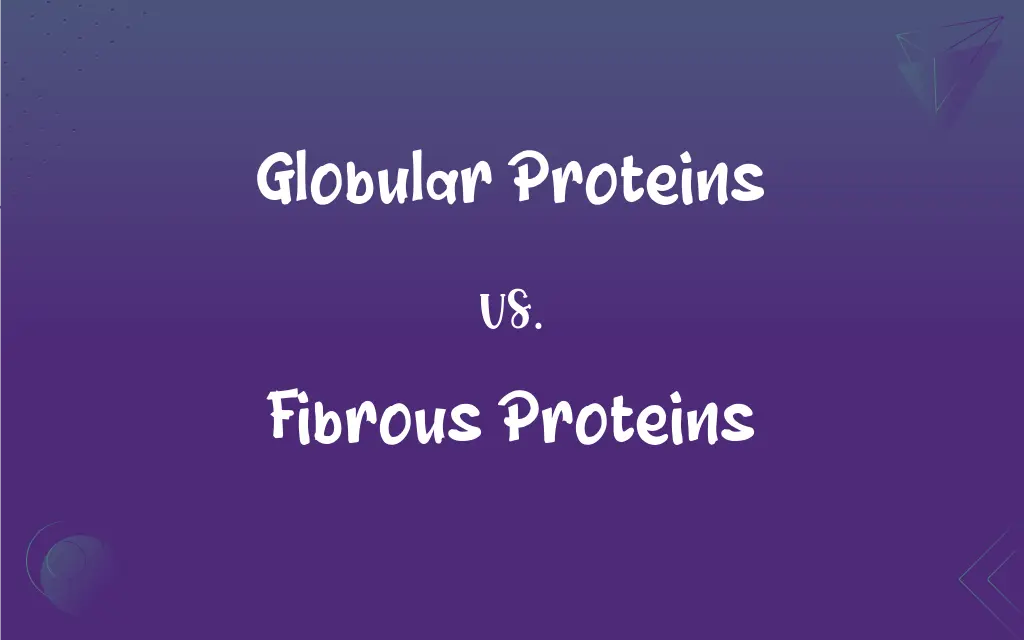Globular Proteins vs. Fibrous Proteins: What's the Difference?
Edited by Janet White || By Harlon Moss || Updated on October 9, 2023
Globular proteins are spherical, water-soluble molecules, while fibrous proteins are elongated, insoluble, and structurally supportive.

Key Differences
Globular proteins and fibrous proteins represent two distinct classes, each bearing unique structural and functional characteristics that define their roles in biological systems. Globular proteins, adopting a somewhat spherical or globule-like shape, typically engage in a plethora of cellular activities, demonstrating versatility in function. In contrast, fibrous proteins, showcasing an elongated, often rod-like structure, predominantly provide structural support and mechanical stability to cells and tissues.
The solubility of globular proteins in water underscores a crucial functional distinction when contrasted with fibrous proteins. Globular proteins are generally soluble in water due to their hydrophilic exterior, facilitating their involvement in enzymatic, transport, and signaling activities within the aqueous cellular environment. Fibrous proteins, however, tend to be water-insoluble, attributing to their largely structural and mechanical roles, such as forming connective tissues, hair, and nails.
Examining the structural complexity of globular proteins reveals a meticulously folded form that achieves its functional diversity, while fibrous proteins illustrate simplicity and repetition in structure, yielding tensile strength and stability. Globular proteins often display intricate tertiary and quaternary structures, underscoring their capacity to bind various substrates and interact with numerous cellular entities. Fibrous proteins exhibit repetitive amino acid sequences and secondary structures, like alpha-helices or beta-pleated sheets, granting them notable sturdiness and resistance to external stressors.
Considering thermal stability, globular proteins usually demonstrate sensitivity to temperature variations, as their folded structures can denature, adversely affecting function. Conversely, fibrous proteins often exhibit higher thermal stability due to their straightforward, repetitive structures, which may not be easily compromised by temperature fluctuations. Hence, while globular proteins may lose their functionality with slight thermal disruptions, fibrous proteins maintain their structural role effectively under similar circumstances.
From a nutritional perspective, both globular proteins and fibrous proteins play significant roles in organisms, albeit differently. Globular proteins, being enzymatic, hormonal, and transport-oriented, directly influence metabolic and cellular activities, whereas fibrous proteins, due to their structural functionalities, contribute to the physical attributes and mechanical properties of tissues and organs, providing integrity, flexibility, and resilience to biological constructs.
ADVERTISEMENT
Comparison Chart
Shape
Spherical
Elongated, rod-like
Solubility
Generally soluble
Insoluble
Function
Diverse (enzymes, transport)
Structural, mechanical
Structural Level
Tertiary/Quaternary
Secondary
Thermal Stability
Often thermally sensitive
Typically more stable
ADVERTISEMENT
Globular Proteins and Fibrous Proteins Definitions
Globular Proteins
Spherical proteins that are typically water-soluble and have various functional roles in organisms.
Enzymes, a type of globular proteins, catalyze biochemical reactions, enhancing the speed and efficiency of metabolic processes.
Fibrous Proteins
Insoluble proteins with extended conformations, often providing mechanical stability to biological structures.
The toughness of spider silk is attributed to fibrous proteins, which exhibit remarkable strength and flexibility.
Globular Proteins
Proteins characterized by a folded, globule-like structure, often participating in cellular functions.
Antibodies, which are globular proteins, help defend the body against foreign invaders by recognizing and binding to specific antigens.
Fibrous Proteins
Proteins featuring elongated shapes, contributing to the tensile strength and architecture of various tissues.
Elastin, a fibrous protein, confers elasticity to structures such as the skin and blood vessels, allowing them to return to their original shape after stretching.
Globular Proteins
Compact proteins with an irregular ball-like shape, involved in diverse biological activities.
Hemoglobin, a globular protein, plays a crucial role in oxygen transport throughout the vertebrate body.
Fibrous Proteins
Long, string-like proteins that provide structural support and strength to cells and tissues.
Collagen, a fibrous protein, is fundamental in providing structural integrity to various tissues including skin, bones, and ligaments.
Globular Proteins
Compact, generally spherical proteins that have hydrophilic exterior surfaces and are often involved in metabolic processes.
Myoglobin, a type of globular protein, stores and facilitates the movement of oxygen within muscle cells.
Fibrous Proteins
Strand-like proteins typically playing roles in forming supportive networks or fibers within organisms.
Fibrin, a fibrous protein, plays a pivotal role in blood clotting, forming a mesh that traps blood cells.
Globular Proteins
Round-shaped proteins that typically act as catalysts, transporters, or regulators within the cell.
Insulin, a globular protein, is pivotal in regulating glucose levels within the bloodstream.
Fibrous Proteins
Proteins characterized by elongated structures and commonly involved in supportive and protective roles in organisms.
Keratin, a fibrous protein, contributes to the hardness and water resistance of the skin, hair, and nails.
FAQs
Can globular proteins act as enzymes?
Yes, many globular proteins function as enzymes, catalyzing various biochemical reactions.
What are globular proteins?
Globular proteins are spherical, water-soluble proteins involved in various cellular functions like enzyme activities.
Why are globular proteins soluble in water?
The outward-facing hydrophilic residues of globular proteins interact favorably with water, rendering them soluble.
Can fibrous proteins be consumed in our diet?
While fibrous proteins like collagen are present in meat and connective tissues, they are typically not used for energy but can have other health benefits, like supporting joint and skin health.
Are globular proteins present in the blood?
Yes, globular proteins like hemoglobin and immunoglobulins are present in the blood, serving transport and defense functions, respectively.
What role do fibrous proteins play?
Fibrous proteins provide structural support and mechanical strength to tissues and cells.
Are fibrous proteins significant in muscular structures?
Absolutely, fibrous proteins like myosin play a crucial role in muscle contraction and movement.
What gives fibrous proteins their strength?
Fibrous proteins have repetitive amino acid sequences and structured secondary configurations like beta-pleated sheets or alpha-helices, which provide tensile strength and resistance to external forces.
Are globular proteins involved in immune responses?
Absolutely, immunoglobulins, which are globular proteins, are pivotal in identifying and neutralizing foreign objects like pathogens in immune responses.
Are all enzymes globular proteins?
While most enzymes are globular proteins due to their spheroid shapes and solubility, not all globular proteins are enzymes.
Can fibrous proteins be seen under a microscope?
Yes, under powerful microscopes, fibrous proteins can be observed providing structural frameworks in various tissues.
How are globular proteins denatured?
Globular proteins can be denatured by various factors like heat, pH changes, or the presence of detergents, affecting their three-dimensional structure and functionality.
How are fibrous proteins related to scars?
Fibrous proteins, particularly collagen, are instrumental in scar formation by providing a structural matrix for healing and tissue repair in wounded areas.
Are fibrous proteins found in the skin?
Yes, collagen, a type of fibrous protein, is a major component in skin providing structural support.
Can globular proteins be found in cellular membranes?
Yes, some globular proteins embed in cell membranes, acting as receptors or channels to facilitate communication and transport across the membrane.
Do globular proteins have a role in genetic expression?
Yes, some globular proteins, like transcription factors, play pivotal roles in gene expression and regulation.
Do fibrous proteins exhibit enzymatic activities?
Generally, no. Fibrous proteins predominantly play structural and mechanical roles rather than catalyzing biochemical reactions like enzymes.
Can globular proteins transport other proteins within a cell?
Yes, certain globular proteins, like chaperones, assist in the proper folding and transport of other proteins within a cell.
Are fibrous proteins involved in cellular signaling?
Generally, fibrous proteins are not directly involved in cellular signaling but may facilitate signaling by providing structural support to cells and tissues.
How can globular proteins be purified for study?
Techniques like chromatography and electrophoresis are commonly employed to isolate and purify globular proteins for research purposes.
About Author
Written by
Harlon MossHarlon is a seasoned quality moderator and accomplished content writer for Difference Wiki. An alumnus of the prestigious University of California, he earned his degree in Computer Science. Leveraging his academic background, Harlon brings a meticulous and informed perspective to his work, ensuring content accuracy and excellence.
Edited by
Janet WhiteJanet White has been an esteemed writer and blogger for Difference Wiki. Holding a Master's degree in Science and Medical Journalism from the prestigious Boston University, she has consistently demonstrated her expertise and passion for her field. When she's not immersed in her work, Janet relishes her time exercising, delving into a good book, and cherishing moments with friends and family.
































































